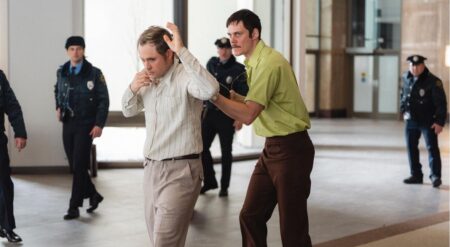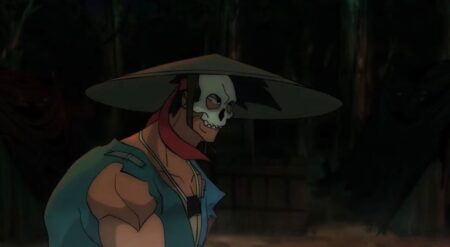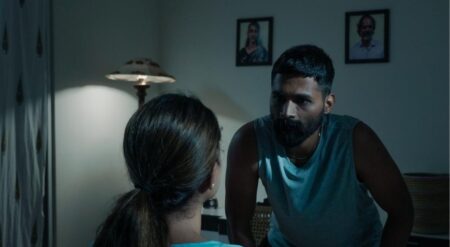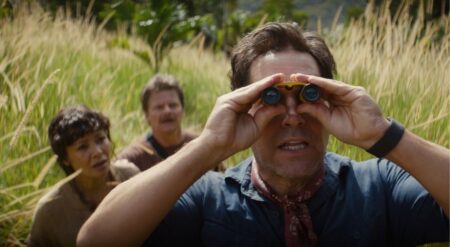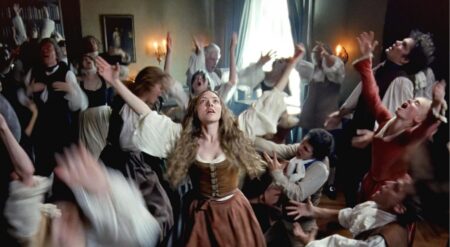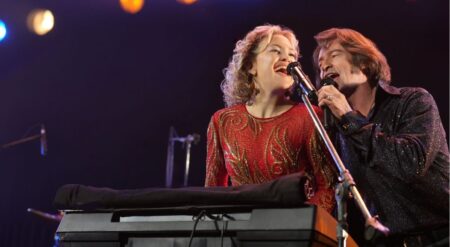The Marvel Cinematic Universe (MCU) may have been more critically well-regarded based on its last film, but the fan fatigue at the end of Phase 5 can’t be understated. Still, The Fantastic Four: First Steps aims to start Phase 6 with something fresh, and for the most part, the film, directed by Matt Shakman and written by Josh Friedman, Eric Pearson, Jeff Kaplan, and Ian Springer, wears its multiple writers on its sleeves.
Set against the vibrant backdrop of a 1960s-inspired, retro-futuristic world, The Fantastic Four: First Steps introduces the First Family of Marvel. Created by Jack Kirby and Stan Lee in 1961, the film follows Reed Richards/Mister Fantastic (Pedro Pascal), Sue Storm/Invisible Woman (Vanessa Kirby), Johnny Storm/Human Torch (Joseph Quinn), and Ben Grimm/The Thing (Ebon Moss-Bachrach) after they have their cosmic accident.
In addition to the core cast, the film also stars Paul Walter Hauser, John Malkovich, Natasha Lyonne, and Sarah Niles. With this intimate cast of characters, if Galactus’ plan to devour the entire planet and everyone on it weren’t bad enough, things quickly get very personal.
The CG effects are fantastic during large battles, but the computer animation in small sequences is immersion-breaking.

Unlike the adaptations before it, The Fantastic Four: First Steps doesn’t focus on the group’s cosmic accident. Instead, this film takes place after the events, and more importantly, after the family has made a name for themselves with world organizations, sunscreen ads, and a friendly neighborhood smile.
Forced to balance their roles as heroes with the strength of their family bond, they must defend Earth from a ravenous space god called Galactus (Ralph Ineson) and his enigmatic Herald, Silver Surfer (Julia Garner). Ultimately, they must make the decision to protect their family or the planet.
The film’s most glaring flaw is its CGI. The visual effects are so bad that the original 20th Century Fox film fares better than this, and it’s not even in the big moments where characters show their powers. Instead, it’s in the smaller moments when characters pass a baby to one another or interact with the world around them.
Where The Fantastic Four: First Steps can create large-scale moments against Galactus and the Silver Surfer, known as the Herald in this film, the downtime spent with characters and more emotional moments fall flat due to terrible CGI. The difference in the creative team’s ability to pull off large-scale sequences and small human moments is frustrating to say the least.

In the film’s third act, there is an emotional moment that is supposed to act as the film’s true climax. One that worries you and captures a mother’s love. Only I couldn’t do anything but laugh because of how badly the characters on the screen are rendered.
In one moment, they look like they’re actually in the space, and then the next moment, they look like someone calling in with a greenscreen in the background. And even that is more forgiving when compared to the other moments, still, when characters look entirely made out of Play-Dough. It’s just not good.
Despite The Fantastic Four: First Steps’ attempts to make you believe in its characters, their passion, and their world, bad effects work consistently shatter any and all immersion. It’s awkward at best and cheap at worst, which leaves me questioning whether or not Disney has decided to compensate its animators in a way that actually facilitates good work.
The Fantastic Four: First Steps continues the MCU’s subpar CGI effects work that has plagued it in the last two phases, largely due to underpaying artists and studios, as well as introducing compressed timelines. But where the lack of visual fidelity weakens the film, The Fantastic Four’s biggest strength is that you often forget about the MCU entirely. Much like The Eternals, this isn’t a film concerned with anything else going on in other parts of the collapsing cinematic universe and its better for it.
The Fantastic Four: First Steps’ retrofuturistic production and costume design is stellar.

With a gorgeous devotion to the retrofuturistic world that Jack Kirby created with Stan Lee, the phenomenal set design is met by an embrace of Kirby’s characters. This is not the Fantastic Four from recent iterations; it is as close as you can get to Kirby’s work. And for the most part, it exists in its pocket within Marvel, not touching the main MCU until the film’s mid-credit scene, which shoehorns everything we just saw into a cinematic universe on the decline.
Visually, the casting, costume design, and architectural aesthetics embody Kirby’s vision of a futuristic New York, yet still evoke the 1961 origins in a way that keeps its legacy in clear view in almost every scene of the film. The scenes throughout the film that put the heroic team under a microscope and show the audience the uniqueness of their world compared ot the one we’ve come to know in Marvel’s larger cinematic legacy. That is where Shakman excels, both as a director and as part of the writing team.
The Fantastic Four: First Steps maintains this homage to its legacy throughout, as it represents its big bad: Galactus. A larger than life devourer of worlds, Galactus is unlike anything else we’ve seen in the MCU. While the scale makes him akin to Dr. Strange’s Dormammu, the physical nature of the final fight makes it work extremely well. Each of the quartet attempts to make a dent in Galactus’s armor, and when they each fail, they fall back to their intelligence. Not just Richards’ smarts, but everyone else’s too.
The start of Phase 6, First Steps, embraces heroic tropes but sets its own standards too.

Seeing the Fantastic Four work together in the field, while also peeking into their daily lives, allows each of them to lead with their humanity. Despite being a superhero group with the entire world’s trust to defeat a planet-eating threat, the narrative tries its hardest to portray them as more than just people trying to do their best.
At times, it works, and at others, it feels too idealistic, but even when I disconnect from the idea of refusing to sacrifice one life to save a planet, it ultimately captures the heroes that Kirby dreamed up 64 years ago.
Much of the success in this regard comes from the cast’s chemistry in varying amounts. The romantic chemistry between Pedro Pascal’s Reed Richards and Vanessa Kirby’s Sue Storm isn’t always electric. However, their chemistry as parents is. But the shining relationship of the film is the brotherly banter between Ebon Moss-Bachrach’s Ben Grimm and Joseph Quinn’s Human Torch (even if he looks like James Gunn’s Fred from Scooby Doo.
Each of the characters latches onto the others like family, and it shows. In one moment near the film’s mid-point, we see Sue instruct Johnny to kill the Silver Surfer to protect the family, and while the moment is humorous, the seriousness is there. Not to mention Herby, the robot, is the best non-human addition to the MCU in some time.
Motherhood is one of the key narrative elements in this take on The Fantastic Four as much as Galactus.

There are choices that The Fantastic Four: First Steps makes that I never thought could find their way into a Marvel movie. While the film’s take on family may be reductionist, it is rewarding for the most part, at least until the finale. While some bring too many spoilers to discuss, it is worth noting that motherhood takes center stage in the film, albeit primarily in a reductionist sense.
Here, Sue Storm as a mother supercedes Sue Storm the hero, and world leader. She is a mother first and everything else second. While there is strength in seeing a woman fight while pregnant and even take on a planet-eating superbeing like Galactus only to protect her child, it does push me into a territory that I increasingly have a harder time navigating the older I get. Are our selfish familial connections more important than our duties to keep others safe?
If the answer is yes, then you will have no problem with The Fantastic Four: First Steps. Suppose your answer is no and you believe that a hero’s selfishness includes doing the hard thing for the betterment of humanity. In that case, you’ll find the film’s midpoint and Sue’s “empowering” speech about family more eye-roll inducing than moving.
This Fantastic Four film struggles in more minor special effects moments but succeeds with Galactus and Silver Surfer.

However, what Kirby’s Sue Storm captures is the devotion of a mother, so much so that you will take on a galactic god and your people to keep your child safe. Still, as the film navigates the complications of making this choice, Sue and Reed’s strained relationship comes to the forefront, even if it’s something I wish could have been explored more thoroughly beyond a moment of anger that is quickly forgotten.
While I have critiqued the film’s CGI in the small moments, I have to give credit for how the film captures Galactus, refusing to shrink him to Earth’s scale and instead aiming to take on the tall task of making his big, dumb helmet intimidating. And they accomplish it.
Sure, I’ve got my issues with the weird CGI baby, but in the final fight, Sue Storm’s light-bending powers are at their best, Mr. Fantastic is stretched to an unsettling breaking point, and Johnny and Ben each play their roles perfectly, from minimal to lifesaving. At times, the awkwardness in their powers is accentuated by the film’s ’60s inspiration, and it winds up more charming than not.
It’s hard not to root for characters like we see in The Fantastic Four: First Steps.

The latter duo offer up more than enough humor, but they each are also able to evoke some emotion, even if Johnny’s real concern is whether or not the Silver Surfer’s surfboard is attached, for obvious reasons that make perfect sense for Johnny Storm.
The Fantastic Four: First Steps is a tough film for me. It’s a look at what the MCU can be if allowed to thrive without the baggage of television series homework or immediate tie-ins, but the film throws it away in the mid-credits stinger. Despite its unique visual design and 1960s period, Feige can’t help but make the first family of Marvel be a part of the larger MCU, even if it’s to the film’s detriment. Ultimately, this film succeeds when you forget about anything that came before it and whatever has been announced after, whether it’s opening up Phase 6 or not.
If anything, this is a film that makes a case for the erasing of the cinematic universe that has begun to crumble under the weight and expectations of 10-year plans and tie-in television series. While we know it won’t escape the pull of Avengers: Doomsday, one can only hope that Disney and Marvel Studios will let the multiverse thrive without making us see everything touch and intersect.
The Fantastic Four: First Steps thrives on family first.

I’d take a standalone sophomore film for this team, or more importantly, this family. And as someone who is completely tapped out on what the MCU has to offer, that’s saying something. By taking “the first family of Marvel” literally, First Steps understands what makes the Fantastic Four click as a group and has ultimately kept them relevant for over 60 years.
But when you have to bring everything full circle into other properties, it’s hard to care for them individually. Instead, we have just to wait for Phase 6 to collapse in on itself like the others after Endgame. But I at least have some hope that this team can withstand it, if only to find shelter in their own corner of Marvel’s filmography away from the rest.
The Fantastic Four: First Steps is just fine. It’s not revolutionary, as it’s hindered by the same constraints that the MCU often imposes on its casts and characters, but it’s at least an attempt to create a distinct world and let these family characters shine in it. However, after Superman (2025), this film is just too comfortable to make a statement, even if it tries to differentiate itself from the crowded Marvel filmography.
The Fantastic Four: First Steps will release in theaters nationwide July 25, 2025.
The Fantastic Four: First Steps
-
Rating - 6.5/106.5/10
TL;DR
The Fantastic Four: First Steps is just fine. It’s not revolutionary, as it’s stunted by the same constraints that the MCU often saddles its casts and characters with, but it’s at least an attempt to build a different world and let these family characters shine in it.


